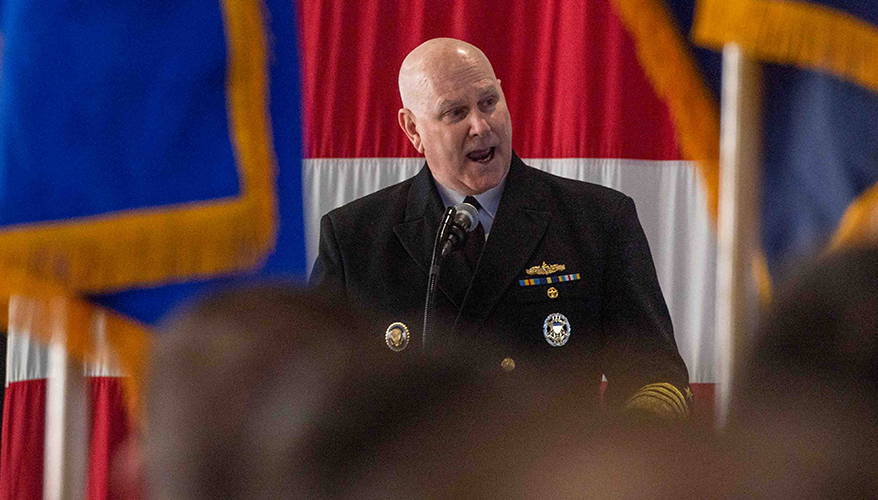BATTLEFIELD COMMUNICATIONS
BREAKING: It’s Time to Move Out on CJADC2 Capabilities, Adm. Grady Insists
5/1/2024
By Josh Luckenbaugh
By Josh Luckenbaugh
 Vice Chairman of the Joint Chiefs of Staff Navy Gen. Christopher Grady
Vice Chairman of the Joint Chiefs of Staff Navy Gen. Christopher Grady
Defense Dept. photo
The U.S. military services each have their individual contributions to the Defense Department’s Combined Joint All-Domain Command and Control initiative, but the services are increasingly working together to make the concept a reality, the Vice Chairman of the Joint Chiefs of Staff said May 1.The initiative, known as CJADC2, envisions the U.S. military — along with allied forces — tying together all sensors and shooters on an artificial intelligence-enabled network to enable faster decision-making on the battlefield.
Different services have different efforts to get after CJADC2: the Army has Project Convergence, the Navy Project Overmatch and the Air Force the Advanced Battle Management System. But Vice Chairman of the Joint Chiefs of Staff Navy Adm. Christopher Grady said that having observed each service’s progress on CJADC2 recently, “I think increasingly the services are working together.”
While each service may “have a different approach to it … they are working together to bring capability that can be integrated,” Grady said during a Center for Strategic and International Studies event. Grady noted he and Deputy Secretary of Defense Kathleen Hicks have put together a CJADC2 steering group “to really start to pull this all together.”
“One of the things that that we — especially she — has been stressing is, hey, we got to start talking about leave behind” and arriving at a minimum viable capability that can be fielded, he said.
The Defense Department’s Chief Digital and Artificial Intelligence Office has run a series of CJADC2-related events called the Global Information Dominance Experiments, and after past iterations, the department would simply “write a report,” he said. “Now … that's not good enough. We're going to do it and we're going to leave behind some capability and start moving out.”
Hicks announced the delivery of a minimum viable capability for CJADC2 in February, saying it showed “the beauty of what software can do for hard power,” according to a Defense Department release.
Grady said at the CSIS event: “This emphasis … on outcomes that empower the [combatant commands] … it's about getting them capability faster. So, is it perfect yet? No, but we're working on it.”
One of his key goals in his final 18 months as vice chairman is to “solve that creative tension of the current and the future,” Grady said. The Defense Department must improve how it does force design, figuring out “how do we think about the future, the changing character of warfare [and] how are we going to get there?”
The Joint Staff has stood up a joint future steering group, “and it's my goal to make that one of the most important meetings that we go to,” he said. The hope is that the steering group “is very much outcomes-based and helps us do that force design piece.”
While the department plans for the future and moves out on the priorities set out in the 2022 National Defense Strategy — which identifies China as the United States’ pacing challenge — at the same time the department cannot take its eye off the present strategic environment, Grady said.
“The world gets a vote on these things, and certainly what's happening in Ukraine, or what's happening in Gaza, or what's happening in the Red Sea, or even into Africa if you want to go there, these are all things that are challenges that we have to work through,” he said. Conflicts and geopolitical tensions across the globe “stress test” if the United States can “devote our attention where we really need to … particularly in the Western Pacific.”
While striking that balance between the present and future “is challenging, I am confident that we are still able to do that,” he said. The Defense Department is working through “where forces are portioned” — made even more challenging by the attacks by Houthi rebels in the Red Sea — “but we'll work our way out of that.”
“I do think that if you have empowered leadership like you have” at U.S. Indo-Pacific Command and U.S. European Command, “they articulate very well … the acute challenge and the pacing threat,” he said. “Challenging, yes, but I think we've been able to achieve where we want to go with the” National Defense Strategy.
Topics: Battlefield Communications
